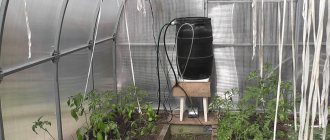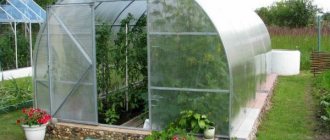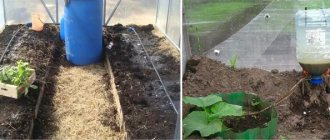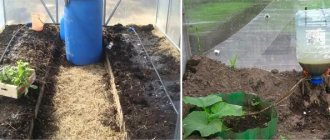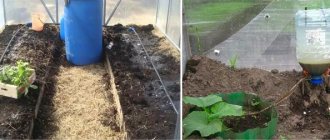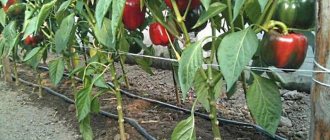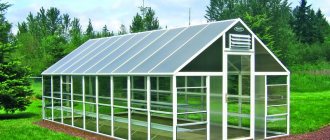Watering cucumber bushes using an automated drip system makes the work of the vegetable grower easier. It eliminates the need to carry water in buckets or rearrange hoses. Many people construct drip irrigation for cucumbers in a greenhouse or open ground on their own. To do this, large containers and hoses are used to supply water to each plant. For proper operation of the system, the planting pattern of cucumber bushes and the method of liquid supply are taken into account.
Advantages and disadvantages
The drip irrigation system is popular among gardeners, especially among those who do not live in the country or cannot be there all the time. To prevent plantings from dying from the heat, this method of moistening the soil works flawlessly, and besides, water consumption during drip irrigation is minimal. Gardeners note the following advantages:
- moisture flows gradually to each plant in the soil;
- the roots are reliably protected from drying out;
- no hard crust forms on the ground;
- weeds do not appear in the aisles;
- leaves remain dry, reducing the risk of mold and fungal diseases;
- the productivity indicator increases;
- the ground remains loose.
There are disadvantages to using a drip irrigation system. This:
- the appearance of blockages inside the droppers;
- the system is easily damaged mechanically, hoses are chewed by animals;
- financial costs for the purchase of components and equipment.
Although there are disadvantages, they are insignificant compared to the advantages of this method. It doesn't require a lot of water pressure. Summer residents face this problem in the spring and summer: due to overload, the water from the pipeline barely flows, so they have to wait a long time. If drip irrigation is installed on the site, then you don’t have to wait - even a small stream is enough to moisten the ground.
Which crops prefer regular moisture supply?
Most of all, drip irrigation affects the yield of tomatoes. This crop is sensitive to excess moisture and temperature fluctuations. With high humidity and cold air, any variety of tomato loses resistance to disease. If there is excess water, the tomato fruit cracks and the taste weakens.
Moisture-loving crops are cucumbers and bell peppers. They respond well to regular watering. Unlike tomatoes, they get sick less often, but excess also causes fungal infections.
All crops are susceptible to the application of liquid fertilizers. The yield of cabbage, cucumbers, zucchini, tomatoes, and peppers increases several times.
The physical arrangement of crops in the beds is very convenient. For example, the tall, strong stem of a tomato at the base of the ground is devoid of leaves. The soil surface is clean and level, which makes maintenance much easier. You can always check the degree of soil moisture. The lower leaves of the cucumber are specially removed to prevent contact with wet soil.
If you are engaged in the commercial cultivation of peppers, cucumbers, tomatoes and other crops, then you cannot find a more reliable automatic assistant than an adjustable feed system.
So, any design that provides drip of moisture into the greenhouse with minimal participation of the vegetable grower makes the work easier. Makes it possible to do all the work yourself and ensures good productivity.
landscapeportal.ru
Tags: greenhouse
Trackback from your website.
Watering rules
Cucumbers need to be watered correctly, taking into account the characteristics of the vegetable. The root system of plants is located close to the soil surface, in the upper layer of the earth. If you water the plants abundantly, the moisture does not stay in the top layer for a long time and quickly goes down. The surface dries out quickly, and the roots lack moisture. To prevent this from happening, the following conditions must be observed:
- during the period of formation of ovaries and ripening of greens, watering is increased;
- You need to moisten the soil as close to the bush as possible, water the plant near the root;
- for irrigation, use only rain or settled water, a little cool, but not icy;
- comply with the norm of water consumption per square meter. It depends on the variety grown, soil composition, climatic characteristics of the region;
- if the leaves look wilted, then increase the rate;
- In cloudy and rainy weather, plants are not watered.
If there is a lack of moisture in the soil, the taste of greens will become unpleasantly bitter, it will be impossible to eat them, which means the crop can be thrown away. If the soil is over-watered, this will have a detrimental effect on the development of the root system and the health of the plants. The culture is quickly affected by a fungal infection, rots and dies.
Attention!
Before watering the plantings, you need to assess the condition of the soil. If it is dry to a depth of more than 5 cm, you need to water the plants.
Arrangement methods
There are four main methods by which you can create a bottle irrigation system. Therefore, before starting work, you should familiarize yourself with each of them.
Digging into the ground
The most common way to arrange irrigation in open ground is to bury containers in the ground with the bottom down. To do this, a small hole with a depth of at least 10 cm is made near each bush, into which the container will be placed. Then, using a tape measure, remove 3-5 cm from the beginning of the bottom of the bottle and make a mark. After this, holes in several rows are created in the marked area using a heated needle. About 10 holes need to be made.
See also Description of the cucumber variety Sheer perfection, its characteristics and care Read
The prepared bottle is carefully wrapped in cloth and placed in the ground upside down. Then it is buried and filled with water. Often, debris and soil fall into the water from above. To solve this problem, you should cover the neck with nylon or cloth.
Digging upside down
This method differs from the previous one in that the container will be placed in the ground upside down. Therefore, holes will have to be made in the lid or neck. To organize watering using this method, holes for containers are made near each bush. At the same time, you need to make them a little less than last time. Their depth should be equal to the size of the container neck.
Having finished creating the holes, you can begin preparing the containers. Using a well-heated nail, you need to make 5-10 holes on the lid or neck. If the soil is not very dense, then their number can be reduced.
After this, measure five centimeters from the bottom of the container and cut off the bottom of the container using scissors or a knife. Some gardeners do not cut it off completely and leave it to protect it from debris and quickly evaporate moisture. Then the neck is wrapped with cloth and it is placed in the ground.
Hanging
Some people do not want to expose the root system of cucumbers and therefore they refuse to dig containers near the bushes. It is in such situations that it is recommended to use this method. To organize watering using this method, you must first make holes in the bottom of the container. Several holes are also made to pass the wire through which the container will be attached.
After this, a structure is mounted above the bush to secure the container. Its height should not be too high. It is necessary that the distance from the bottle to the ground is about 40 cm.
Application of attachments
This method is the most expensive, since you will have to purchase special attachments for the bottles. Using them, you don’t have to waste your time digging containers into the ground. It will be enough just to attach the nozzle to the neck and deepen it into the ground.
Irrigation rates
When installing drip irrigation for cucumbers in a greenhouse, you need to take into account the fact that moisture in a film or polycarbonate cover evaporates slowly. In cloudy weather, the temperature in a closed structure is higher than outside, as well as during hot periods. As soon as the first leaves appear on the plants, the application rate should be no more than 2 m per square meter. When ovaries form on cucumber seedlings, watering is increased to 4-5 liters. In hot weather, cucumbers in a greenhouse need to be watered every 2 days, and in cloudy weather it is enough to water once every 4-5 days.
If drip irrigation for cucumbers is installed in open ground, then the hole will differ from the greenhouse one. During flowering and fruit formation, at least 6-10 liters of settled cool water should be used. In hot weather, agronomists advise watering the crop every day or at least every other day, and on cloudy days the norm is reduced to 1-2 times every 5 days. By the end of summer, when fruiting ends, 5 liters of water per m2 will be enough.
Sprinkling
Cucumbers require moisture for both the roots and the above-ground parts. The large leaves of the plant intensively evaporate water. To replenish moisture in the leaves and stems, sprinkler irrigation is carried out. In this case, watering cans, hoses with spray nozzles, and various types of sprinklers are used. However, it must be taken into account that sprinkling can be used when the cucumbers are completely healthy. If you suspect symptoms of powdery mildew, spotting or anthracosis, the sprinkler irrigation method should be immediately eliminated and switch to drip irrigation.
The leaves and stems of cucumbers will gratefully respond to outside root watering
Proper irrigation of such a moisture-loving crop as cucumber requires knowledge and practical experience. Having become familiar with various methods of watering and applying them when growing this wonderful vegetable, the gardener will always have a harvest.
Temperature compliance
To obtain a large amount of harvest, in addition to moistening the soil, you need to observe the temperature regime when growing cucumbers in a polycarbonate greenhouse. It affects the growth of fruits and their taste characteristics. If the regime is not followed, diseases progress, and the crop is quickly affected and may even die. Comfortable temperature conditions for cucumbers should be as follows:
- during the daytime from 15 to 20 degrees;
- at night and in the evening 18-20 degrees.
The temperature should not change sharply; a sharp drop of several degrees is not acceptable at any time of the day. To make it easier to control the temperature in the greenhouse, install a thermometer. The readings are assessed daily. If the seedlings were just planted outside, and frost suddenly began at night, you can raise the temperature in several ways:
- mulch the soil;
- lay black cloth on the ground;
- cover with planting film.
If the greenhouse, on the contrary, gets too hot during the day and the temperature in it exceeds 20 degrees, it is reduced by ventilating through vents and doors.
On a note!
The cucumber root system stops absorbing moisture if the temperature drops to 10 degrees.
How does the composition of water affect cucumbers?
Cucumbers are sensitive to water pH. A high level of hardness will provoke slow growth and poor development of vegetable crops. If the liquid in the water supply has such indicators, it is recommended to use citric acid or vinegar during irrigation.
- Particular attention must be paid to the composition of the water.
- If it contains various mineral salts, chemicals must be added to the liquid to stimulate the fruiting process.
- For example, watering cucumbers with iodine performs two functions simultaneously.
- Plants are saturated with beneficial micro-compounds, and their root system will be protected from attack by insects, fungi and mold.
Loosening will help normalize oxygen access to the inner layers of soil. It allows you to get rid of weeds and prevents the proliferation of fungi.
DIY installation of a structure for irrigating cucumbers
With a drip irrigation system, the distance between the plants and the dropper must be maintained at 3-5 cm. Water for irrigation is supplied from a barrel or tank using a pumping device. If you install the container with liquid at a height, then there is no need for a pump, since the liquid will flow to the plantings by gravity. Drip tapes can be used instead of hoses. Sometimes gardeners make punctures in them so that moisture reaches the plants little by little, but constantly. In order to build a drip irrigation system in your garden plot, you will need:
- a container with a volume of 50 liters or more (capacity depends on the size of the planting);
- faucet with shut-off valve;
- hoses, droppers, tubes;
- connectors, adapters;
- a device that controls water flow.
Gravity drip system
Drip irrigation of cucumbers in open ground will be carried out using it, or in a greenhouse - it doesn’t matter, it is suitable for both cases.
Choose a suitable container. Its volume should be enough for the number of beds that you have. The base for it can be assembled with your own hands from boards. If there are several beds, then it will be enough to install the barrel at a height of 1.5-2 meters. By the way, try to immediately find a barrel that has a tap on it, then you won’t have to install it yourself. It must be installed from below, but at a distance of about 7-10 cm from the lower base, so that debris accumulating at the bottom does not enter the system. Each bed should have one drip tape or one hose with small holes. You can make them yourself, but it would be a good idea to purchase a model with already built-in droppers. This makes it easier to calculate the distance between each cucumber bush so that the watering tape supplies moisture directly to the root system.
Reviews
Tamara Vasilievna, 60 years old
Last year, my husband found a use for the extra hoses at the dacha - he installed a drip irrigation system for cucumbers from the pipes. Now you don’t need to constantly walk with buckets, trample on the beds and get your feet wet. When the need for watering arises, I open the tap on the barrel, and the liquid flows by gravity directly to the root system. Watering cucumbers with drip irrigation is very convenient, I advise everyone, but just do not forget to clear the pipes from blockages. After using fertilizers, for example, I clean the system with phosphoric acid, it removes plaque well.
Peter
I made drip irrigation for cucumbers and tomatoes in the spring. It took a lot of materials, we have several greenhouses in the country, so we had to try hard. Within a few days the system was ready. I supply water from a 200 liter tank with a pump; I also installed a controller to measure the liquid flow. Immediately in the first month I noticed savings in water; drip irrigation uses much less than the usual method.
The drip irrigation system is recognized as effective; thousands of gardeners have already felt the benefits from it. It will make it easier to care for the crop, and the result will not take long to wait. This method will definitely prevent rotting of the root system, and the greens will be without voids inside, fragrant and sweet in taste.
Water supply through a pumping station or from the main water supply
Hoses prepared for drip irrigation can be connected to the main water supply, but in this case you need to install a pressure regulator. It will limit the pressure of incoming water to within 1 atm. You just need to take into account that the water supply usually comes from cold water, which is not suitable for watering cucumbers.
A homemade drip irrigation system can also be connected to a pumping station. The main function of such stations is to maintain a given pressure in the system. Such a station can be installed near a water source, which can be interconnected tanks, barrels, pools and other containers of sufficient volume. The pumping station can be connected to the tank using a suction hose with a check valve and filter, or through a stationary pipe at the bottom of a barrel or other container with water.
If the tap is opened, the pressure will drop, the pump will automatically turn on and water will begin to flow into the system. Water drips quite slowly from drip irrigation tapes and hoses. Therefore, the pump will turn on and off from time to time. The pumping station can be installed in some room and operate automatically while you are not in the garden.

